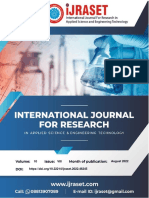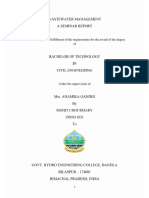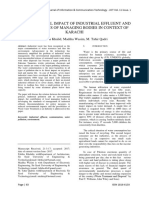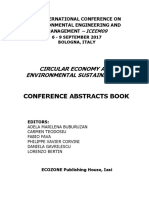Treatment of Wastewater by Effluent Treatment Plant: Mr. Aditya Agrawal, Mr. Jayesh Shrivastav
Uploaded by
siti anisaTreatment of Wastewater by Effluent Treatment Plant: Mr. Aditya Agrawal, Mr. Jayesh Shrivastav
Uploaded by
siti anisaJournal of Environmental Engineering and Studies
Volume 3 Issue 1
Treatment of Wastewater by Effluent Treatment Plant
Mr. Aditya Agrawal1, Mr. Jayesh Shrivastav2
1
Assistant Professor, Civil Engineering Department
Prestige Institute of Engineering Management & Research, Indore (M.P.)
2
P.G. Student, Civil Engineering Department
SGSITS, Indore (M.P.)
Abstract
Several rivers basins are closed due to the excessive growth in the agricultural area, semi
urbanization as well as in the industrialization. The performance of wastewater treatment
plants for the treatment of small waste also does not meet the required standards. For
example, wastewater from wastewater treatment plants, which are often unsuitable for
domestic use and reuse of wastewater, are mostly limited to agricultural and industrial uses.
The development of innovative technologies for the treatment of wastewater from various
industries is a worrying problem for us. Although numerous research papers on wastewater
pollution studies have been published, little research is being done in the iron and steel
industry on wastewater treatment, especially with regard to the development of treatment
systems. Another aspect of this research will be the reuse of water, sludge from various
industries, etc.
Keyword: Wastewater, Effluent Treatment Plant (ETP), Environmental Impact Assessment
and Physical Treatment.
INTRODUCTION household water, such as drinking,
Water Availability and its uses: preparing food, washing, washing clothes
One of the most important natural resource and dishes, pulling toilets, and covering
which is present on the earth surface is turf and toilets.
WATER. The country's total available
water resources were estimated at about
1123 BCM (433 BCM from the ground
and 690 BCM from the surface), which
represents only 28% of the rainfall. About
85% (688 BCM) of water consumption is
diverted to irrigation (Figure 1), which
could reach 1072 BCM by 2050. The main
source of irrigation is groundwater.
The Uses of Water for the different Ways Fig 1: Water used by different sources
are as follows:
For commercial purposes, fresh water As per the industrial point of view it is
available various hotels, restaurants, office being uses for the following purposes like
buildings and other commercial facilities. processing, cleaning, transportation,
Domestic use of water is probably the dilution and cooling in manufacturing
most important daily water consumption facilities. The most important water-
for most people. consuming industries are steel, chemicals,
paper and oil refining. Industries use the
Domestic use includes water that is same water again and again for more than
consumed daily in the home, including one purpose.
1 Page 1-8 © MAT Journals 2018. All Rights Reserved
Journal of Environmental Engineering and Studies
Volume 3 Issue 1
Irrigation water is used artificially for of human, ecological health and related
crops, orchards, pastures and horticultural risks, and the presence of changes in the
crops, as well as for willow irrigation, to services of nature in certain projects. This
protect against frost and frost, for chemical is the term used to assess the
use, for cooling crops and leaching of environmental impact (positive and
salts. Root zone. The use of mining water negative) of a particular plan, policy,
includes water for the extraction of natural program or project before deciding to
minerals; Solids such as coal and ores; proceed with the proposed action. In this
Liquids such as crude oil; and gases like context, the term "Environmental Impact
natural gas. This category includes Assessment" (EIA) is generally used when
extraction, grinding (screening, screening, applied to specific projects either by
washing and flotation) and other activities individuals or any companies, and the term
related to mining activities. A significant "Strategic Environmental Assessment"
portion of the water used for mining, about (SEA) is more commonly applied to
32 percent, is salt. policies, plans and programs proposed by
public authorities. Environmental audits
Wastewater can come from the may be governed by administrative
following sources such as: procedural rules relating to public
Human excreta (feces and urine) often participation and documentation of
mixed with used toilet paper or wipe, if decision-making and subject to judicial
it is collected with flush toilets. review.
Washing water (personal, clothes,
floors, dishes, cars, etc.), also known Purpose of EIA-
as greywater or sullage. The main purpose of an environmental
Surplus manufactured liquids from impact assessment (EIA) is to identify
domestic sources (drinks, cooking oil, and evaluate potential impacts
pesticides, lubricating oil, paint, etc. (positive and negative) of development
Urban Rainfall runoff from roads, car and the various projects in the
parks, roofs, sidewalks/pavements environmental system. It provides a
(Contains Oils, Animals feces, litter, useful aid for decisions based on the
gasoline/petrol, diesel, metals understanding of environmental
exhausted from the vehicles, etc. implications, including social impacts,
Highway drainage (oil, de-icing are cultural and aesthetic issues that
agents, rubber residues, particularly can be incorporated into the analysis of
from tires) the costs and benefits of the project.
Storm drains (may include trash) This task must be carried out early
Manmade liquids (illegal disposal of enough in the planning phase of the
pesticides, used oils, etc.) project for the selection of
Industrial waste Industrial site drainage environmentally friendly sites, process
(silt, sand, alkali, oil, chemical technologies and other environmental
residues) protection measures.
Although all industrial projects may
Environmental Impact Assessment have an environmental impact, they
(EIA)- may not be significant enough to
Environmental Assessment (EA) - An warrant costly assessment procedures.
Environmental Impact Assessment (EIA) The need for such exercises should be
is a means of assessing various factors, decided after an initial assessment of
such as the impact of environmental health the potential impact of a particular
project and its location. Projects that
2 Page 1-8 © MAT Journals 2018. All Rights Reserved
Journal of Environmental Engineering and Studies
Volume 3 Issue 1
can be subject to a detailed carried out. ETP plants are widely used in
environmental impact assessment the industrial sector, for example in the
include the following: pharmaceutical industry, to eliminate bulk
drug effluents.
The treatment of industrial wastewater
includes the mechanisms and processes for Need for ETP -
wastewater treatment, which is a by- To clean the effluent from the industry
product of industrial or commercial and recycle it for later use.
activities. After the treatment, it can be Reduce the use of drinking / fresh
reused or may be discharged into the water in industries.
nearby water bodies or streams. However, To reduce the expense of acquiring
many industries continue to depend on the water.
processes that produce wastewater. To acquire the standards for the
emission or discharge of
The Various types of Wastewater environmental contaminants from
Treatment Process are: ETP, STP and various industries established by the
CETP government and avoid hefty penalties.
Some of the major important types of Protect the environment from pollution
wastewater treatment process are as and contribute to sustainable
follows: development.
1. Effluent Treatment Plants (ETP)
2. Sewage Treatment Plants (STP) Treatment Levels & Mechanisms of
3. Common and Combined Effluent ETP –
Treatment Plants (CETP). 1. Treatment levels: Preliminary Primary
2. Secondary Treatment
It is estimated that 1.8 million people die 3. Tertiary Treatment (or advanced)
each year from waterborne diseases. A
large part of these deaths can be indirectly Preliminary Treatment: The separation
attributed to inadequate sanitation. of large impurities such as leaves, cloth,
plastic, wood, branches of tree, etc. The
Wastewater treatment is an important operations are: Screening: It is a screen
initiative that should be taken more which can be manually operated or
seriously to improve society and our mechanically operated of uniform size
future. Wastewater treatment is a process provided to prevent the entry of large
in which pollutants are removed from impurities. Generally its having a size of
domestic wastewater and wastewater to 10 mm. Sedimentation: In this process
produce solid waste or solid waste for the particles are settled down due to
discharge or reuse. gravity of the suspended particles.
Clarification: They are used for the
Effluent Treatment Plants (ETP): separation of solids from fluids.
The main aim of the pharmaceutical and
chemical industries is to purify water and Primary treatment level Purpose:
remove toxic and non-toxic materials and Removal of floating and settleable
chemicals from it. These plants are used materials such as suspended solids and
by all companies for environmental organic matter.
protection. Example: pH control, coagulation,
chemical precipitation and oxidation. pH
An ETP is a plant in which the treatment control to adjust the pH in the treatment
of industrial and wastewater effluents is process so that the pH of the wastewater is
3 Page 1-8 © MAT Journals 2018. All Rights Reserved
Journal of Environmental Engineering and Studies
Volume 3 Issue 1
neutral. Anaerobic processes: An Anaerobic
For acidic waste (low pH): NaOH, process is defined as the process which
Na2CO3, CaCO3 or Ca(OH)2, etc. takes place in the absence of oxygen. It
For alkaline residues (high pH): H2SO4, uses microorganisms (anaerobes) that do
HCl, etc. not require air (molecular / free oxygen) to
assimilate organic impurities. The final
Chemical coagulation and flocculation: products are methane and biomass.
Coagulation refers to the accumulation
of tiny solid particles dispersed in a Tertiary / advanced treatment Purpose:
liquid in a larger mass. Final cleaning process that improves the
Chemical coagulants such as Al2(SO4)3 quality of wastewater before being reused
{also called alum} or Fe2(SO4)3 are recycled or discharged into the
added to the wastewater to enhance the environment.
attraction between the fine particles so Mechanism: Removes the remaining
that they join together and form larger inorganic compounds and substances, such
particles called flocs. as nitrogen and phosphorus. In this it
A chemical flocculant (usually a removes the remaining inorganic
polyelectrolyte) improves the compounds such as nitrogen and
flocculation process by collecting the phosphorus. Bacteria, viruses and parasites
particles to form larger flakes, which that are harmful to public health are also
settle more quickly. eliminated at this stage.
Flocculation is aided by a gentle
mixture that causes the particles to Methods: Alum is used to help eliminate
collide. phosphorus particles and remaining solids
to facilitate their extraction in the filters.
Aerobic processes: An aerobic process is The chlorine contact tank also disinfects
defined as the process which takes place in the tertiary treated wastewater by
the presence of oxygen. It uses those removing microorganisms in treated
microorganisms (aerobic), which use wastewater, including bacteria, viruses and
molecular / free oxygen to assimilate parasites. The remaining chlorine is
organic impurities that is converting them removed by adding sodium bisulphate just
into CO2, H2O and biomass. before it is discharged.
Fig 2: Flow chart for ETP
4 Page 1-8 © MAT Journals 2018. All Rights Reserved
Journal of Environmental Engineering and Studies
Volume 3 Issue 1
ETP Plant Operation:
1. Screen chamber: Eliminate relatively 6. Aeration basin: The water has passed
large solids to avoid abrasion of like a thin film on the different
mechanical equipment and facilities, like the shape of a staircase.
obstruction of the hydraulic system. Water comes into direct contact with
2. Collection tank: The collecting tank the air to dissolve oxygen in the
collects the effluent water from the water. The BOD and COD values of
screening chamber, stores it and the the water are reduced by up to 90%.
pump then to the equalization tank. 7. Clarifier: The clarifier collects
3. Equalization tank: Effluents from biological sludge. The overflowing
the collection tank are stored from 8 water is called treated and removed as
to 12 hours (approximately) in the effluent. The quality of the outgoing
equalization tank which results in a water is controlled to within the limit
homogenous mixing and helping in allowed by the Indian Standards
neutralization. It eliminates shock Office. Through pipelines, treated
loading on the subsequent treatment water is dispersed in river water, in
system. Continuous mixing also dry soils, etc.
eliminates settling of solids within the 8. Sludge thickener: The inlet water
equalization tank. Reduces SS, TSS. consists of 60% water + 40% solids.
4. Flash mixer: coagulants have been The wastewater is passed through the
added to the effluents: centrifuge. Due to the centrifugal
action, solids and liquids are
Lima: (800-1000 ppm) To correct pH separated. The sludge thickener
up to 8-9 reduces the water content in the
Alum: (200-300 ppm) To remove the wastewater to 40% water + 60%
color solids. The wastewater is then
Polyvinyl electrolyte: (0.2 ppm) to reprocessed and the sludge is
solve suspended problems and reduce collected at the bottom.
SS, TSS. The addition of the 9. Dryer: Primary and secondary sludge
abovementioned chemicals by fast and is dried on drying beds. Flow Chart of
efficient mixing facilitates the ETP Screening Equalisation (Lime +
homogeneous combination of floc to Alum) pH = 8.5 SS, TSS Elimination
produce microflocules. Dispersion Unit RECYCLE TANK
Sedimentation Basin (pH = 7.5)
5. Clarriflocculator: In the Sludge Thickening Unit Biological
Clarriflocculator the water Treatment and Aeration {Assay =
continuously circulates through the (Urea + DAP) for removal O2} BOD
stirrer. The overflowing water is again ~ 90% COD Waste ~ 90% Sludge
brought into the aeration basin. The discharge Wastewater discharge
solid particles are then deposited, Wastewater discharge 60% water +
collected separately and dried; this 40% solids 40% water + 60% solids.
reduces SS, TSS. But on the other 10. Screening: Screening is the filtration
hand the Flocculator provides a slow process for the separation of coarse
mixing which result in the formation particles from influent. Stainless steel
of macro flocs and thus they are net with varying pore size can be
deposited in the clarification zone. utilized. Screens are cleaned regularly
The remaining solids are pumped into to avoid clogging.
sludge drying beds.
5 Page 1-8 © MAT Journals 2018. All Rights Reserved
Journal of Environmental Engineering and Studies
Volume 3 Issue 1
Fig 3: Flow Chart of ETP
Equalization Tank: for our environment, clean and healthy.
The main purpose of the equalization tank
makes the waste water homogenous. In an activated sludge process, the
Retention time depends upon the capacity wastewater treatment plant is a biological
of treatment plant. (Generally 8-16 hours) process that can be used for one or more
purposes, such as the oxidation of
MATERIALS AND METHODS: carbonaceous organic material that
Methodology: In this research paper the comprises a material containing oxidizing
treatment technologies adopted for treating nitrogen, mainly ammonium and nitrogen
sewage are as follows: in materials biological, the elimination of
phosphate and the dispossession of
Activated Sludge Process entrained gases such as carbon dioxide,
Chlorination ammonia, nitrogen, which produce a
Filtration biological flake that easily settles which
Wastewater treatment is the process of produces a fluid, which contains little
eliminating pollutants from wastewater dissolved or suspended material. In the
and domestic wastewater, both runoffs process air or oxygen in a mixture of
(wastewater), domestic, commercial and sewage or treated industrial and purified
institutional. It includes physical, chemical primary wastewater is introduced in
and biological processes to eliminate combination with organisms to develop a
physical, chemical and biological biological flake that reduces the organic
contaminants. Its purpose is to provide a content in the wastewater. The
wastewater (or treated effluent) combination of wastewater and biological
environment stream and a solid waste (or mass is commonly known as mixed liquor.
treated sludge), which is suitable for In all activated sludge systems, the excess
disposal or reuse. Wastewater treatment is mixed liquor is after the water from the
not only important for our health, but also wastewater or waste has been treated
6 Page 1-8 © MAT Journals 2018. All Rights Reserved
Journal of Environmental Engineering and Studies
Volume 3 Issue 1
sufficiently in the sedimentation tank is addition, these systems have the cost of
discharged and is supplied to the treated construction, maintenance and lower
supernatant before extraction to further operation because they are powered by
treatment. A part of the sedimented natural energy from the sun, wind, earth,
material, the sludge is recycled to the head microorganisms, plants and animals.
of the ventilation system, in order to return Therefore, for a planned deployment,
the seed of the new wastewater that enters strategic, safe and sustainable sewage
the tank. This portion of the flakes is appears to be a need for coherent policies
called return activated sludge. and programs decisions that should include
the decentralized effluent at lower cost
The excess sludge will remove the excess treatment technologies, bio filters, strains
sludge from the said treatment process in efficient microbial and organic / inorganic
order to balance the relationship between modifications suitable cultures /
the biomass and the food in the wastewater Cultivation systems, cultivation.
and is processed by digestion, both under
anaerobic conditions and aerobic before REFERENCES
disposal. The activated sludge refers to 1. Dean J. G., F. L. Basqui and
biological treatment processes that use Lanouette, 1972, Removing heavy
suspended growth of organisms to remove metals from wastewater Env. Sci.
the BOD and suspended solids. The Tech. 6:518
process requires a ventilation tank and a 2. Huang C. P. 1977, Removal of heavy
sedimentation tank. The settling tanks are metals from industrial effluents J. Env
decanting tanks equipped with mechanical . Eng. Division, ASCE 118 (EE6):
means for the continuous removal of 923-947.
sediment deposits. The disinfection of 3. Loomba, K. and G. S. Pandey 1993,
wastewater is necessary for healthy rivers Selective removal of some toxic metals
and streams. ions (Hg(II), pb (II) and Zn(II)) by
reduction using steel plants granulated
Microorganisms are present in large slag. Indian J. Env., Health A:20:105-
numbers in sewage and waterborne disease 112.
outbreaks have been associated with 4. Shrivastava, A.K., A Review on
sewage-contaminated water supplies. copper pollution and its removal from
water bodies by pollution control
CONCLUSION Technologies, IJEP 29(6): 552-560,
The problems associated with the reuse of 2009.
wastewater are due to a lack of treatment. 5. Journal of environmental Management,
So the challenge is to avoid low-cost, low- vol. 88, issue 3, August 2008, pp. 437-
tech and easy-to-use methods that, on the 447.
one hand, are designed to significantly 6. Industrial wastewater reuses potential
reduce the existence of wastewater and, – internet (web)
secondly, threaten to protect our valuable 7. Waste Management Strategies for
natural resources. The use of constructed industries.
wetlands is now recognized as an efficient 8. U.S. Environmental protection
technology for wastewater treatment. Agency, Design criteria for
Compared to traditional treatment systems, Mechanical, Electric and Fluid system
Constructed Wetlands requires less and Washington, D. C.,1974.
material and energy, is easy to use, has no 9. L. D. Robescuet. al., Mathematical
problem disposing of the sludge, and can modeling of Sharon Biological
be serviced by untrained personnel. In Wastewater treatment Process, U. P. B.
7 Page 1-8 © MAT Journals 2018. All Rights Reserved
Journal of Environmental Engineering and Studies
Volume 3 Issue 1
Sci. Bull. Series D, 74(1), 2102, pp.
229-236.
10. Anonymous. 2004. NATP – MM
project report on ‘Use of Urban and
Industrial Effluent in Agriculture’
CSSRI, Karnal 132001, India
11. Bhamoriya V. 2004. Wastewater
Irrigation in Vadodara, Gujarat, India:
Economic Catalyst for Marginalized
Communities. In: Scott CA, Faruqui
NI and Raschid-Sally L. (Eds).
Wastewater Use in Irrigated
Agriculture: Confronting Livelihhod
and Environmental Realities. CAB
International in Association with
IWMI: Colmbo, Sri Lanka, and IDRC:
Ottawa, Canada.
12. Bhardwaj RM. 2005. Status of
Wastewater Generation and Treatment
in India, IWG-Env Joint Work Session
on Water Statistics, Vienna, 20-22
June 2005.
8 Page 1-8 © MAT Journals 2018. All Rights Reserved
You might also like
- Review Wastewater Treatment in Different IndustriesNo ratings yetReview Wastewater Treatment in Different Industries8 pages
- Basic Tutorial - Wastewater Management - Shiv Shankar Ranganathan PDFNo ratings yetBasic Tutorial - Wastewater Management - Shiv Shankar Ranganathan PDF2 pages
- Effluent_Treatment_Plant_ijariie20710 (1)No ratings yetEffluent_Treatment_Plant_ijariie20710 (1)2 pages
- Industrial Water Treating Systems: 4 Waste Water - Treatment Technologies and Recent Analytical DevelopmentsNo ratings yetIndustrial Water Treating Systems: 4 Waste Water - Treatment Technologies and Recent Analytical Developments2 pages
- Purification of Wastewater by Metal Oxide NanoparticlesNo ratings yetPurification of Wastewater by Metal Oxide Nanoparticles12 pages
- A Review of Wastewater Treatment TechniquesNo ratings yetA Review of Wastewater Treatment Techniques6 pages
- Wastewater Treatment by Effluent Treatment PlantsNo ratings yetWastewater Treatment by Effluent Treatment Plants8 pages
- Module I BTCVPE 604 A Industrial Waste Treatment 27 Feb2023No ratings yetModule I BTCVPE 604 A Industrial Waste Treatment 27 Feb202347 pages
- "Effluent Treatment Plant in Process IndustryNo ratings yet"Effluent Treatment Plant in Process Industry29 pages
- WASTE WATER TREATMENT PLANT REPORT Final-1No ratings yetWASTE WATER TREATMENT PLANT REPORT Final-116 pages
- Effect of Industrial Effluents On StreamsNo ratings yetEffect of Industrial Effluents On Streams13 pages
- Effluent Treatment Plant Design Operation and Analysis of Waste WaterNo ratings yetEffluent Treatment Plant Design Operation and Analysis of Waste Water75 pages
- Types of Wastewater Treatment Process: ETP, STP and CETPNo ratings yetTypes of Wastewater Treatment Process: ETP, STP and CETP5 pages
- 1 Industrial Wastewater Treatment MergedNo ratings yet1 Industrial Wastewater Treatment Merged20 pages
- Effluent Treatment Plant: Rajat Mani Thapliyal Dheerendra Singh Pradeep Madhukar Kaushal ShakyaNo ratings yetEffluent Treatment Plant: Rajat Mani Thapliyal Dheerendra Singh Pradeep Madhukar Kaushal Shakya25 pages
- Advantages and Disadvantages of Techniques Used For WastewaterNo ratings yetAdvantages and Disadvantages of Techniques Used For Wastewater11 pages
- a44dc531-a374-40a8-bfab-a1a9ec9465f1_Chapter_1_and_2No ratings yeta44dc531-a374-40a8-bfab-a1a9ec9465f1_Chapter_1_and_218 pages
- Advantages and Disadvantages of Techniques Used For Wastewater TreatmentNo ratings yetAdvantages and Disadvantages of Techniques Used For Wastewater Treatment11 pages
- Handbook of Water and Wastewater Treatment Technology 9781351441889 1351441884 9781351441896 1351441892 0 8247 9277 7 - CompressNo ratings yetHandbook of Water and Wastewater Treatment Technology 9781351441889 1351441884 9781351441896 1351441892 0 8247 9277 7 - Compress840 pages
- A Review On Industrial Wastewater Treatment Via Electrocoagulation ProcessesNo ratings yetA Review On Industrial Wastewater Treatment Via Electrocoagulation Processes32 pages
- Environmental Impact of Industrial Effluent and Contributions of Managing Bodies in Context of KarachiNo ratings yetEnvironmental Impact of Industrial Effluent and Contributions of Managing Bodies in Context of Karachi13 pages
- An Insight Review On Textile Effluent Treatment Using NanoparticlesNo ratings yetAn Insight Review On Textile Effluent Treatment Using Nanoparticles33 pages
- Hydrology Current Research Waste Water TNo ratings yetHydrology Current Research Waste Water T12 pages
- Operational Activities and Factory Overview With Petty Cash Analysis of ZZFLNo ratings yetOperational Activities and Factory Overview With Petty Cash Analysis of ZZFL71 pages
- Water Reuse From A Circular Economy Perspective - 2018 - Current Opinion in Envi PDFNo ratings yetWater Reuse From A Circular Economy Perspective - 2018 - Current Opinion in Envi PDF14 pages
- UK Greywater Recycling: An Information GuideNo ratings yetUK Greywater Recycling: An Information Guide27 pages
- Food, Jobs and Sustainable Cities: Urban AgricultureNo ratings yetFood, Jobs and Sustainable Cities: Urban Agriculture31 pages
- Design and Testing of A Prototype Mechanical Drainage Waste Collector For Caramcam District, Mangagoy, Bislig CityNo ratings yetDesign and Testing of A Prototype Mechanical Drainage Waste Collector For Caramcam District, Mangagoy, Bislig City13 pages
- Dairy Wastewater Generation and CharacteristicsNo ratings yetDairy Wastewater Generation and Characteristics5 pages
- Waste Management Plant in Bangladesh (Economies)100% (3)Waste Management Plant in Bangladesh (Economies)22 pages
- History of and Current Trends in Wastewater Treatment: With Input by Lee WalkerNo ratings yetHistory of and Current Trends in Wastewater Treatment: With Input by Lee Walker25 pages
- Hydra Bio Blocks For Grease Trap Bacteria TreatmentNo ratings yetHydra Bio Blocks For Grease Trap Bacteria Treatment4 pages
- Microbes: What They Do & How Antibiotics Change ThemNo ratings yetMicrobes: What They Do & How Antibiotics Change Them4 pages

























































































